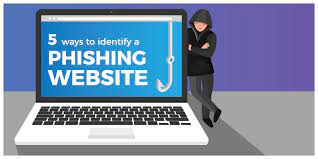Phishing can occur when you visit a phishing website directly, rather than solely through email or social media. Here are a few of the most important signs.
Phishing is a recurring issue in terms of online security. Many people receive phishing material via emails or social media sites. However, you can potentially arrive at a phishing website straightaway. What exactly is a phishing website? How do you recognize one?
What Is a Phishing Website?
A phishing website is a false online location created to look like a legitimate one. The majority of the time, people run into them after getting scam emails that instruct them to click on links to get there. However, consumers might also end up on phishing websites by inputting a URL incorrectly or by following links in messages on social media that appear to be genuine.
Some hackers deliberately break into legitimate websites to transform them into unreliable sources of information. They might, for instance, include malware on the website to infect users’ computers or steal financial information. Given these dangers, it’s critical to understand how to spot phishing websites. Here are a few of the most important signs.
How to Identify a Phishing Website
Searching for potential phishing websites can be done in five steps. These will significantly aid in their identification and avoidance.
1. Check the Website URL
Start by taking a look at the website’s address to see if anything odd jumps out at you. Perhaps you are aware that the website you wish to visit should end in “.com,” but this one ends in “.org.”
Some hackers create websites that are so expertly faked that nobody thinks to check the URL. The rest appears to be in order, so they continue conversing. However, to surprise users, fraudsters frequently design websites with a few minor typos or additional characters.
2. Go to the Website a Different Way
A lot of individuals click on links in emails or on social media feeds to end up on phishing websites. It can also be risky to access the website using a search engine link. The Washington Post reported on how hackers’ adverts frequently show up at the top of search results. These URLs are used to direct people to phishing websites.
Going to a website without clicking on a link is one of the simplest ways to confirm that it is legitimate. Enter the URL by hand and go there that way. Make sure you spell everything correctly, and then check to see if the website displays as you had hoped.
3. Examine the Content
Once you’ve arrived at a website, carefully review the material. Is it of a high standard and pertinent to the business’s field? Hackers frequently launch phishing websites so quickly that they don’t give a damn about the quality of the writing. In any case, they don’t anticipate anyone reading it.
Searching for a Contact Us page on the website is also beneficial. Typically, phishing sites won’t have one, and fraud websites could not have GDPR warnings too. The crooks don’t want any means for irate website users to contact them after being duped. Furthermore, cybercriminals wouldn’t leave such a clear path for law enforcement to follow in order to track them down.
4. Watch for Pop-Ups
Almost all phishing schemes aim to get victims to act immediately. Because of this, it’s typical to arrive at a phishing website and be greeted by a pop-up window requesting information.
A lot of trustworthy websites contain pop-up ads that try to sell you products. Phishing websites, on the other hand, are more likely to ask for your login credentials or credit card information.
5. Look for Reviews
One of the best things about the internet is that it provides regular people with a forum for discussing both positive and negative business experiences. For this reason, you should look for reviews of a phishing website. In order to increase their authenticity, the hackers may have written bogus ones, so look for them elsewhere than the site itself.
Examine the reviews for veracity after you locate them. Do you notice any recurring themes, words, or phrases? Those are indications that website reviews are being made by people who aren’t actually users.
What to Do if You Clicked on a Phishing Website
Acting quickly is essential to minimizing the harm if you think a phishing site has misled you. By submitting a Google Safe Browsing report, you can mark the website. By doing this, you can alert others to the risk.
If you entered any payment data on the phishing site, change your bank’s contact information and all of your passwords. If you gave information that would allow hackers to steal from you, file a police report.
Additionally, run a scan using an antivirus program if you suspect that something dangerous may have been installed on your device. In fact, it’s better to be safe than sorry, so it’s important to do this even if you don’t believe anything has been downloaded.
Websites That Phish Are Common
During routine internet browsing, phishing websites are becoming more and more common. However, being aware of the warning indicators helps reduce your risk of falling into a scam.
